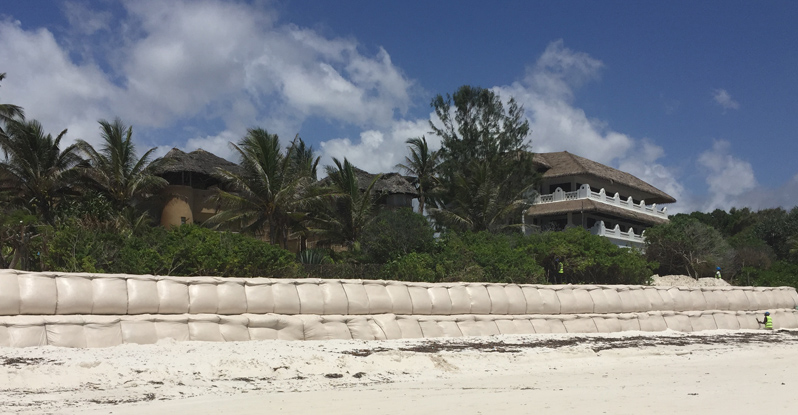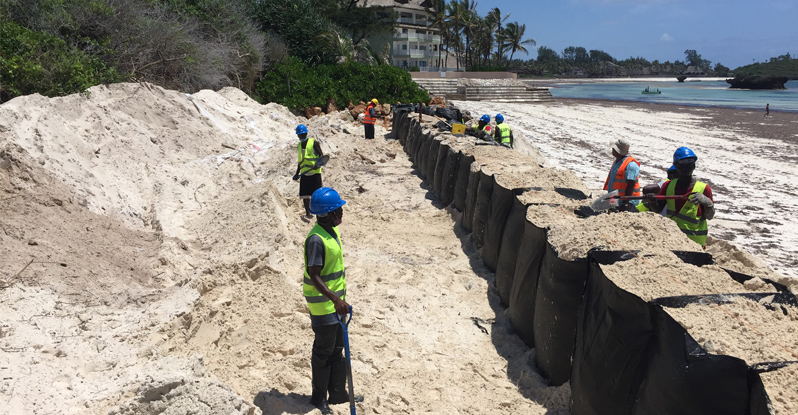Watamu Beach Restoration Using TrapBag®
TrapBag® recently partnered with Geotextiles East Africa to restore a stretch of Watamu beach along the east coast of Kenya.

TrapBag® recently partnered with Geotextiles East Africa to restore a stretch of Watamu beach in front of Medina Palms, a resort along the east coast of Kenya. Our TrapBag® products not only restored the sandy beach, but also were installed to prevent future erosion from damaging the beautiful shoreline.
How Coastal Erosion Affects the East African Coastline
The east coast of Africa suffers from the effects of coastal erosion largely due to climate change. Problems like coastal erosion, flooding, and groundwater salinization can all be traced back to rising sea levels.
In general, Africa’s eastern coastline sits lower than its western, central, or Mediterranean coasts. These low, sandy beaches are prime targets for erosion. Coastal erosion puts other vital ecosystems, like coral reefs and mangrove forests, in jeopardy. It also threatens Africa’s tourism industry as well as the safety of homes, businesses, and hotel resorts like Medina Palms.
Wave erosion in particular has proven to be a problem for the east coast, particularly Kenyan beaches like Watamu. Waves bring powerful energy and gather up sediments that then hit the shoreline. The energy combined with the sediment has an effect similar to sandpaper, eroding the shore. Preventing wave erosion requires some way to dissipate the energy of the waves before they crash onto the coast.
Problems Caused by Coastal Erosion
Coastal erosion can cause a variety of devastating problems, including:
- Loss of beaches: Erosion in coastal areas threatens the very existence of beaches. Over time, beaches affected by coastal erosion will simply disappear.
- Harm to development: Eroding sand and soil does not provide a stable foundation for homes, businesses, roads, or other development projects. Erosion can devastate coastal communities, causing them to seek safer ground inland.
- Decreased tourism: Kenya was ranked the third largest tourism economy in Sub-Saharan Africa in 2019. Tourism makes up nearly 10% of Kenya’s GDP, and the country’s warm, sandy beaches are part of what attracts tourists. If Kenya’s coastal cities lose their beaches to erosion, the tourism economy will decrease.
- Loss of wildlife: Coastal east Africa boasts a rich marine biodiversity, including marine turtles, great white sharks, dugongs, shrimp, tuna, and more. These incredible species are put in jeopardy when coastal erosion and climate change in general damage their habitats.
What Is Beach Nourishment?
Beach nourishment is a form of coastal restoration that slows or stops the effects of erosion. Most beach nourishment projects utilize two forms of restoration:
- Sand: Adding more sand directly to the beach can help slow the effects of erosion. However, it’s important that the right type of sand is reintroduced into the environment. Sand that is too fine can easily wash away, furthering the effects of erosion. Additionally, the wrong type of sand can disrupt or destroy native plants.
- Vegetation: Plant roots stabilize rocks and sand and prevent them from being washed away by the waves. It’s always best to reintroduce native plants as a method of beach nourishment instead of introducing new plants not native to the area. Working with native plants helps restore the beach without negatively affecting its unique ecosystem.
Using TrapBag® for Beach Nourishment
In addition to reintroducing sand and native plants, TrapBag® products can also be deployed to restore eroding beaches. TrapBag® barriers can disperse wave energy and prevent the beaches behind them from eroding away. This decreases the cost and frequency of reintroducing sand and vegetation to the beach, increasing the effectiveness and longevity of traditional beach nourishment efforts.
TrapBag® consists of pentagon-shaped bags made of high-strength textiles and filled with sand, gravel, or concrete. Each bag is connected to the other like an accordion, sharing a common wall. The series of bags is easily deployable and resistant to damage; if one bag fails, it will not compromise the effectiveness of the rest of the barrier.
TrapBag® Protection System for Watamu Beach
Our TrapBag® products proved well suited for beach nourishment in east Africa where typical beach nourishment equipment is not readily available. Because TrapBag® is easily deployable and cost effective, they were a great solution for an environment in which heavy machinery is unavailable and stabilizing plants are not native to the local ecosystem. Our series of bags were quickly deployed and simply filled on site with manual labor.
In partnership with Geotextiles East Africa, our TrapBag® products were used to construct a wall approximately two meters high and 97 meters long in front of Medina Palms. With the addition of a sand-colored ultraviolet coating, the TrapBag® wall blended almost seamlessly into the natural appearance of the beach.
TrapBag® was an eco-friendly choice for restoring the Watamu shoreline. Our products did not threaten important natural habitats, such as turtle nesting, and would not deteriorate over time, eliminating the threat of beach pollution. Additionally, native plant life can grow over our TrapBag® wall, strengthening the beach restoration.
Our TrapBag® wall is also helpful for the local tourism industry. Visitors at Medina Palms gained an elevated beach from which to view the breathtaking ocean. The sand-colored UV coating ensured that our beach restoration efforts would not create an unpleasant eyesore in a naturally beautiful environment.[/vc_column_text][/vc_column][/vc_row]
Meet the author
Get the Dirt Before the Flood Hits
Stay ahead of flooding, erosion, and disaster response challenges. The Dirt, TrapBag’s monthly newsletter, delivers field-tested tips, real-world case studies, and the latest in barrier technology straight to your inbox.


